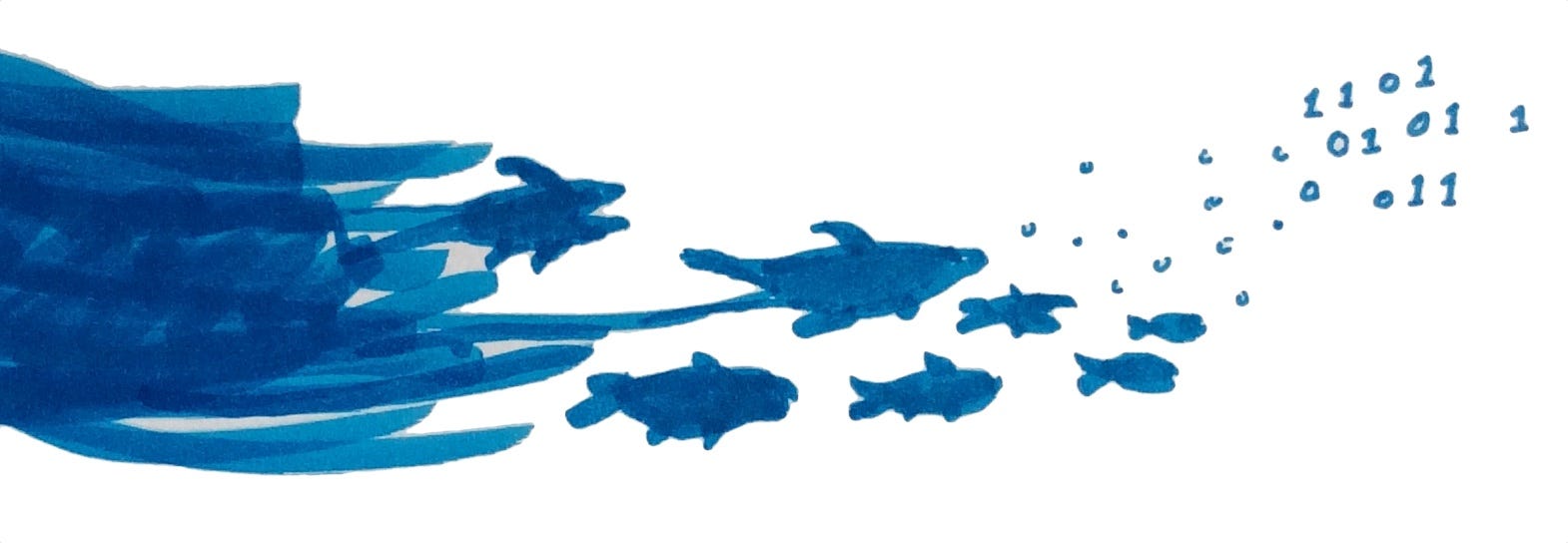
From Medium by Kate Wing
When I walk around Oakland, I see the ocean.
Not because I’m on a hill, or peering through cranes at the port, but because once you know where to look, the ocean is everywhere.
When I watch clouds blow across the sky, I’m watching wind powered by ocean temperatures and currents.
Stacks of folded jeans or the bags of beans at my corner market conjure up images of shipping containers stacked end to end on Panamax ships, slowly plowing through the high seas.
The oxygen I’m sucking in on my run was once carried around the ocean in the grip of cold, cold water molecules.
I first jumped into marine biology in high school and even as I drifted into other fields, I brought that sea view with me.
It’s as if I were a radiologist and I couldn’t stop picturing the bones inside the kid sitting next to me on the train, or a web designer with View Source on all the time.
The sea is the steel behind the building façade, the miniature watch gears beneath the face, the details you take for granted so that you can get on with your task list. Infrastructure — built or grown — succeeds when it moves so smoothly that it’s invisible, and by succeeding in that way, it helps you forget it exists.
The ocean’s imperturbable surface gives the appearance of a miraculous, perpetual motion machine that needs no maintenance from us.
The downside of invisibility is being ignored.
The ocean does need maintenance.
For millennia, we’ve expected it to feed us, take us from one place to another, and keep our weather running along smoothly while we dumped trash and carbon dioxide into it and spent our time with our cooler friend, the moon.
While filming coral off the Solomon Islands, David Gruber, a National Geographic Emerging Explorer, encountered a "bright red-and-green spaceship."
This underwater UFO turned out to be a hawksbill sea turtle, which is significant because it's the first time that biofluorescence has ever been seen in reptiles, according to Gruber.
Gruber is now excited to learn more about this critically endangered species and how it is using biofluorescence.
I mean, we just discovered glow-in-the-dark sea turtles in July.
Almost half of the world’s population lives within 75 miles of the coast now, and rising sea levels are bringing the oceans closer to the other half. It’s time to get to know your neighbor.
To do that, we need give the oceans a little more attention and raise our expectations.
Twenty years ago we didn’t expect glass to respond to our touch or that we could track our packages from the warehouse to our door.
Now we take these things for granted.
Many of our ocean information systems are stuck in the 1980s, or even the 1780s.
We hand enter millions of paper receipts so that six months later we know how many fish were caught.
We call recreational fishermen on the phone and ask them what they caught last month.
We may adopt high-tech tools on one end, like identifying pirate fishing ships with satellites, but the data still flow into outdated systems with limited public accessibility.
It should be easier to see if countries are cheating on their fishing reports, what the pH of the ocean is, or how your shrimp were farmed.
The lack of ocean transparency helps high seas criminals and unscrupulous dealers who want to pass off one fish as another, and it hurts the scientists, fishermen, and managers who are playing by the rules and planning for an ocean that can sustain us through the next millennium.
You don’t have to make the sea your full time job to help open up the oceans (although if you want to, you’d be in good company and the benefits are pretty great).
Whatever you’re doing now, chances are the oceans could use a little bit of your expertise.
The oceans deserve good design and user interfaces.
They need SQL and R and machine vision.
The National Data Science Bowl is a first-of-its-kind competition
asking data scientists to use their skills and big data for social good.
They need data mining to reveal the dynamics at the heart of the ocean’s food system.
They need citizen scientists, entering what they find on beach walks and explorations with their $900 underwater robots.
KnowFish App : winners of the 2015 Fishackathon People's Choice Award!
Right now, the winners of the U.S. State Department’s 2015 fishackathon are at Chile’s global ocean summit presenting their app to help stop illegal fishing.
If you’re wondering what to do with your life, you could do much worse than pivoting to ocean ideas and spending time at fisherpoet festivals.
I imagine a world where the ocean is visible to everyone.
Where your smartwatch can tell you the tides and the surf and what you took out of the sea that day — oxygen, fish tacos, imported printer paper.
Where the back end of your search engine is also compiling and training ocean algorithms.
Where your recaptcha is a sea creature you have to name.
Where you can see your connection to the common sea, and, if you choose, dive in.
It’s time to open up the ocean’s data for the ocean’s sake and for ours.
Links :
- The Guardian : Technology has hurt our oceans, but we can also harness it to reverse the damage
No comments:
Post a Comment